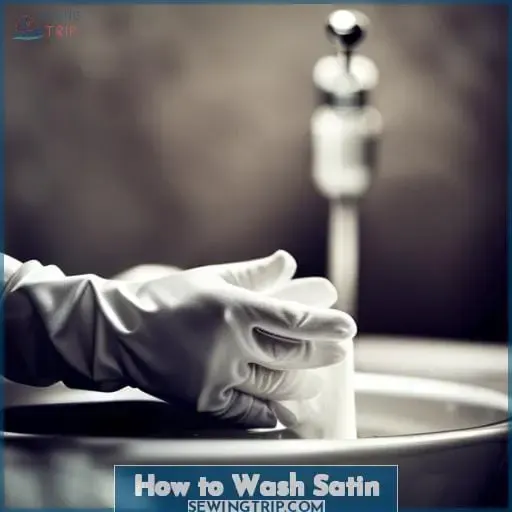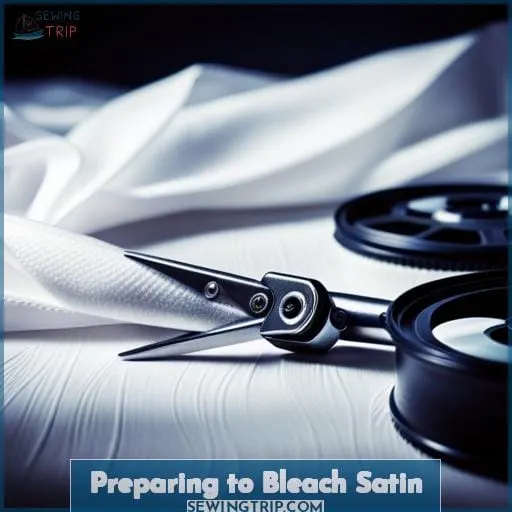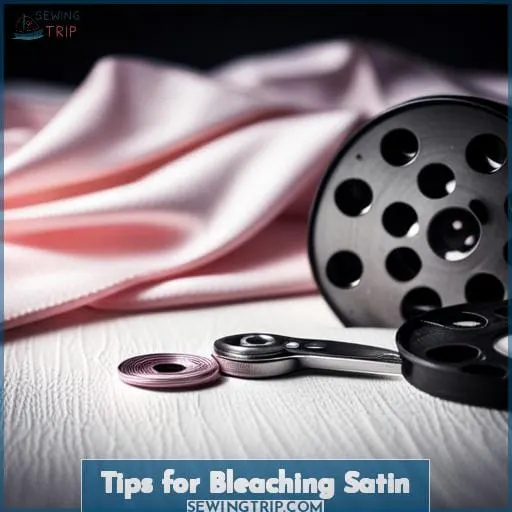This site is supported by our readers. We may earn a commission, at no cost to you, if you purchase through links.
 Ready to conquer those stubborn stains on your satin garments? In this article, we’ll delve into the intriguing world of bleaching satin and explore how you can safely remove unsightly blemishes. Whether it’s a cherished dress or beloved bedding, we’ve got you covered with expert tips and techniques.
Ready to conquer those stubborn stains on your satin garments? In this article, we’ll delve into the intriguing world of bleaching satin and explore how you can safely remove unsightly blemishes. Whether it’s a cherished dress or beloved bedding, we’ve got you covered with expert tips and techniques.
Say goodbye to stains and hello to pristine perfection as we guide you through the process step by step.
Table Of Contents
Key Takeaways
- Satin can be bleached, but it is important to check the care label and conduct a fabric test before attempting to bleach the entire piece.
- Bleaching satin with polyester fibers can cause the fabric to turn yellow, so it is best to avoid bleaching if your satin contains polyester.
- If bleaching is not an option, consider using alternative methods such as color removers or spot treatments specifically designed for delicate fabrics.
- To preserve the beauty of your satin fabric, seek professional advice for stubborn stains and consider dry cleaning or spot cleaning as alternative cleaning methods.
Understanding Satin
To effectively remove stains from satin, it’s essential to have a clear understanding of this delicate fabric.
Satin is known for its smooth and glossy appearance, making it a popular choice for luxurious garments and accessories. It has a lightweight texture and drapes beautifully on the body due to its fluidity.
Satin fabric can be made from various materials such as silk, polyester, or nylon, each with their own unique properties. When caring for satin fabrics, it’s important to check the care label instructions as different types of satins may require specific handling methods.
Some satins are stretchy while others are more rigid in structure. Understanding these characteristics will help you choose the appropriate cleaning method that won’t compromise the integrity of your favorite satin shirt or dress.
How to Wash Satin
To properly wash satin, you’ll need a few supplies and tools.
- Make sure to have a gentle detergent specifically designed for delicate fabrics, such as silk or satin.
- Additionally, you’ll need lukewarm water,
- A clean sink or basin large enough to accommodate your garment without crowding it,
- And a soft towel for drying.
Washing Supplies
When washing satin, gather the necessary supplies to ensure a successful cleaning process.
Here are three essential items you’ll need:
- Laundry detergent: Choose a gentle and chemical-free laundry detergent specifically designed for delicate fabrics like satin.
- Stain remover: Have a stain remover on hand to tackle any stubborn stains before washing.
- Gloves: Protect your hands by wearing gloves while handling the satin.
These supplies will help you achieve clean and pristine results when caring for your precious satin garments or linens.
Tools You’ll Need
To wash satin properly, you’ll need a few essential tools.
- First, make sure to protect yourself by wearing gloves and safety glasses.
- You’ll also need a bucket or sink to soak the fabric in water.
- Use a measuring cup and spoon for precise measurements of cleaning agents like bleach or detergent.
- An iron is necessary for removing wrinkles after washing, while an indoor drying rack provides a gentle way to dry your satin garments without damaging them.
Removing Stains on Satin
To effectively remove stains on satin, you’ll need a few essential tools and follow proper washing techniques.
Start by checking the care label to see if your satin is water-resistant or stain-resistant.
For tougher stains, consider using natural stain removers like vinegar or lemon juice.
Washing Satin
To wash satin, gather the necessary supplies and tools.
Start by filling a sink or basin with lukewarm water and adding a small amount of mild detergent.
Gently agitate the water to create suds.
Submerge the satin item into the soapy water and lightly massage it to remove any dirt or stains.
Rinse thoroughly with cool water until all soap residue is gone.
Avoid wringing or twisting the fabric, instead gently squeeze out excess moisture before laying it flat to air dry or hanging it up using padded hangers for best results in preserving its shape.
How to Iron Satin
To properly iron satin, you need to start by preparing your iron.
Set it on the lowest heat setting and avoid using steam, as it can leave water stains on the delicate fabric.
When ironing satin, be sure to use a pressing cloth or a thin cotton towel between the iron and the fabric to prevent any direct contact that could damage or scorch your garment.
After gently smoothing out any wrinkles or creases with light pressure, hang up your satin item immediately after ironing to maintain its smooth appearance and prevent further wrinkling.
Preparing the Iron
Get your iron ready for the task of pressing satin fabric.
To ensure that you achieve smooth and wrinkle-free results, it’s important to prepare your iron properly.
Set the iron to low heat and make sure that the steam setting is turned off.
Satin should never be exposed to water or steam as it can damage the delicate fibers.
Avoid using any spray products on satin as well.
By following these steps, you’ll be able to safely iron satin without causing any harm or unwanted stains.
Ironing Satin Gently
Now, how do you gently iron satin to ensure its delicate fabric isn’t damaged? Follow these steps for perfect results:
- Use a press cloth: Place a thin cotton or muslin cloth between the iron and the satin to protect it from direct heat.
- Set your iron on low heat: High temperatures can scorch and melt satin, so always use the lowest setting possible.
- Steam away wrinkles: Gently pass the steam setting of your iron over any wrinkles while keeping a safe distance to avoid damaging the fabric.
Ironing Satin Gently
To maintain the beauty and integrity of your satin garments, it’s essential to know how to properly handle them when it comes time for pressing or steaming out any unwanted creases or wrinkles. Ironing satin requires care and attention as this delicate fabric can easily be damaged if not handled correctly. To ensure successful results without compromising quality, follow these expert tips:
1.Use a press cloth
When working with delicate fabrics like satin, using a press cloth is crucial in preventing damage from direct contact with an iron’s soleplate. A thin cotton or muslin cloth works best as it provides an additional layer of protection against excessive heat.
2.Set your iron on low heat
Satin has low tolerance for high temperatures that can scorch or melt its fibers permanently; therefore, always select the lowest temperature setting available on your device before beginning this process.
3.Steam away wrinkles
The steam function on irons helps relax fabrics by softening their fibers which makes removing creases easier than ever before! By holding down onto one side while passing over another area slowly but steadily at sufficient distances (not too close), even stubborn folds should succumb under pressure without causing harm along their journey towards liberation – leaving behind beautifully smooth surfaces ready-to-wear again soon enough! Just remember never allow water droplets linger directly onto satin surface as they can leave unsightly marks once dried up.
Hanging Up Satin
Hang your satin garments carefully to maintain their smooth appearance.
After ironing, it’s important to properly hang up your satin items to prevent wrinkles and creases from forming.
Use a clothesline, shower rod, or drying rack to hang the garment by its shoulders or waistband.
Avoid using thin wire hangers that can leave imprints on delicate fabrics like satin.
For extra security, you can use a pin at the shoulder seams or waistline to hold the garment in place while it hangs and dries naturally.
Can You Bleach Satin?
To safely remove stains from satin, you may be wondering if bleaching is a viable option. Bleaching satin can be tricky and potentially damaging to the fabric, especially if it contains polyester fibers.
- Polyester fibers will turn yellow when bleached.
- If your satin doesn’t contain polyester fibers, then it can be bleached.
- Always test a small piece of fabric before bleaching the entire piece.
- Follow these steps for safe bleach removal:
- Create a bleach solution.
- Submerge the satin in the solution for 5 minutes.
- Rinse thoroughly with cool water.
- Hang dry.
Remember that bleach is strong and should only be used on certain types of fabrics. Take caution when using this method to avoid damage or discoloration on your precious satins.
Preparing to Bleach Satin
Before you begin the process of bleaching satin, it’s important to properly prepare and gather all the necessary supplies. This will ensure that you have everything you need to safely and effectively bleach your satin fabric.
To help guide you in this preparation process, refer to the table below:
| Supplies | Purpose |
|---|---|
| Test fabric | Determine if satin can be safely bleached |
| Hydrogen peroxide | Alternative option for removing stains |
| Color remover | Safely remove color from satin |
| Bleach alternative | Gentle option for lightening stain |
Steamer Refreshes and revives satin
By having these supplies on hand, you’ll be equipped with different options depending on your specific needs when preparing to bleach your satin. Remember to always test a small piece of fabric first before applying any chemicals or methods onto the entire piece of material.
This ensures that there are no adverse effects or damage caused by incorrect application.
Steps to Bleach Satin
Now that you have prepared your satin and gathered the necessary materials, it’s time to begin the bleaching process.
There are a few simple steps to follow in order to effectively bleach your satin fabric.
First, create a bleach solution by mixing household bleach with warm water.
Then, submerge the satin in the solution and allow it to sit for about 5 minutes.
Finally, rinse thoroughly with cool water and dry.
Creating a Bleach Solution
Once you have gathered all the necessary supplies and prepared your satin for bleaching, it’s time to create a bleach solution.
To safely remove stains from satin, follow these steps:
- Choose a chlorine-free type of bleach.
- Mix the appropriate concentration of bleach with warm water.
- Take safety precautions by wearing gloves and working in a well-ventilated area.
Now that your bleach solution is ready, let’s move on to submerging the satin in the solution and allowing it to sit for the recommended time before rinsing.
Submerging Satin in the Solution
Now that you have created the bleach solution, it’s time to submerge your satin in the mixture to begin the process of bleaching.
| Step | Action |
|---|---|
| 1 | Fill a clean sink or bucket with warm water (2 gallons) |
| 2 | Add household bleach (2⅔-cup) and stir well with a long spoon |
| 3 | Gently submerge satin into the bleach solution and stir for even distribution |
| 4 Allow satin to sit in the solution for about five minutes |
Allowing Satin to Sit in Solution
Next, you’ll allow the satin to sit in the bleach solution for five minutes. This step is crucial for ensuring that the bleach effectively removes any stains or discolorations from the fabric. During this time, make sure to gently agitate the satin by stirring it with a long spoon.
After five minutes have passed, drain the bleach solution and rinse thoroughly with cold water to remove any traces of bleach from the fabric.
Rinsing and Drying Satin
First, rinse the bleached satin thoroughly with cool water to remove any remaining bleach solution. Gently swish the fabric around in the water to ensure all traces of bleach are gone. Make sure to rinse thoroughly and avoid using hot water as it can damage the fabric.
After rinsing, carefully squeeze out excess water without wringing or twisting the satin.
Air dry flat in a shaded area away from direct sunlight to prevent fading or discoloration.
Once completely dry, store your bleached satin in a cool, dry place for future use.
Tips for Bleaching Satin
To ensure successful bleaching of satin, follow these helpful tips:
- Test a small piece of fabric before bleaching the entire piece to avoid any potential damage.
- Use gloves to protect your hands from harsh chemicals and bleach.
- Consider using a color remover specifically designed for delicate fabrics like satin instead of regular household bleach.
- After the bleaching process, rinse the satin thoroughly with cold water to remove any remaining residue.
By following these tips, you can safely bleach your satin without causing damage or discoloration.
Alternatives to Bleaching Satin
Now that you know the tips for bleaching satin, let’s explore some alternative methods to safely remove stains from your precious fabric. Bleaching can be a harsh process and may not always be suitable for delicate satin.
- Dry cleaning: Take your stained satin garment to a professional dry cleaner who specializes in handling delicate fabrics like satin.
- Spot cleaning: Gently dab the stain with a clean cloth or sponge dampened with water and mild detergent specifically designed for spot removal on fabrics.
- Color remover: Use color removers specifically formulated for removing stains from colored fabrics without damaging the material.
Frequently Asked Questions (FAQs)
What are the potential consequences of using bleach on satin shoes?
Bleaching satin shoes can have disastrous consequences.
The bleach may not completely remove the dye, and it could even damage the fabric.
Satin containing polyester fibers will turn yellow when bleached, so proceed with caution and test a small piece first.
Is it possible to completely remove dye from satin fabric?
Yes, it’s possible to completely remove dye from satin fabric.
Various chemicals like bleach, hydrogen peroxide, ammonia, acetone, and rubbing alcohol can be used.
Test a small piece first before proceeding with the entire fabric.
Can bleach be safely used on satin containing polyester fibers?
Yes, bleach can safely be used on satin that doesn’t contain polyester fibers.
Simply test a small piece before bleaching the entire garment.
Submerge it in a bleach solution for 5 minutes, rinse thoroughly, and hang to dry for desired results.
How should satin be rinsed after bleaching?
After bleaching satin, you must rinse it thoroughly to remove any remaining bleach.
Fill a sink or bucket with cool water and submerge the satin.
Swish it around before draining the water.
Hang it up to dry and admire your refreshed fabric.
Are there any alternatives to bleaching satin fabric?
To preserve the beauty of your satin fabric, consider alternatives to bleaching.
Instead, try color removers or spot treatments specifically designed for delicate fabrics.
Seek professional advice for stubborn stains and ensure the longevity of your cherished garments.
Conclusion
To achieve satin perfection, you can safely bleach your satin garments to remove stubborn stains. By following the proper steps and techniques, you can restore your cherished satin dresses and bedding to their pristine state.
With the right supplies and tools, you can create a bleach solution and submerge the satin in it, allowing the solution to work its magic. Rinse and dry the satin carefully, and you’ll be amazed at the results. Say goodbye to stains and hello to satin that looks brand new.














